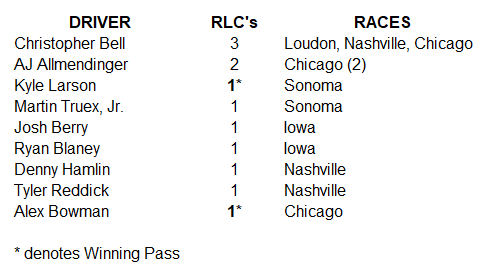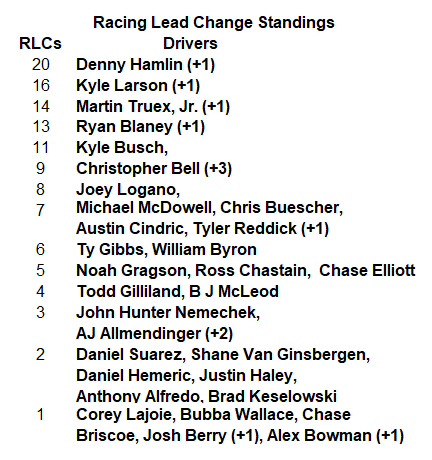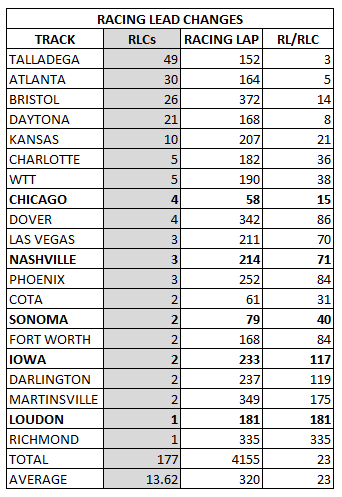As you know by now, I like to report on a variety of race statistics that others don’t report on. Statistics like Racing Lead Changes – a count of how many times a driver took the lead because he passed the leader without benefit of a Caution, leader pitting under Green to hand it over or being bunched up on a restart. Just racing for it, like we all think always happens when NASCAR reports their Lead Change numbers.
I haven’t reported them since Gateway. Mainly because it seemed like there was a ton of controversies that arose in each race that overshadowed the racing and diverted my attention to wading in on those rather than the task at hand. It was like you couldn’t talk about Racing Lead Changes at Nashville without getting sucked into overtimes and the stupidity displayed or the Loudon rain and tire choices/non-choices or Bubba Wallace and Chase Elliott’s Chicago post-race antics. Although I have my opinion on each, others were covering them nicely and throwing one more into the mix wouldn’t add anything to it. I didn’t want to dilute my task by getting sucked into those storms, so I chose to take some time, let the winds die down and waves to settle before I took up Racing Lead Changes again.
Hopefully, things have calmed down enough to do a summary and try to stay away from all the other nonsense of the last few weeks. So here goes…
Overall
In the five races since Gateway (has it really been that long) nine (9) different drivers passed the leaders under green, without benefit of restart or leader pitting to produce 12 Racing Lead Changes.
Driver Breakdown
Christopher Bell was the leading RLC passer with 3 RLC’s. He has one in each of the last three races to also give him the longest RLC streak (last 3 races) as well as making him the only driver to have RLCs in multiple events during this time frame (3 races).
AJ Allmendinger was the only driver to score multiple RLCs in a single event when he made two (2) RLC passes at Chicago.
Seven other drivers had single RLCs over this five-race period, with Josh Berry and Alex Bowman entering the Racing Lead Change competition fray with their first RLCs. This brings the RLC totals to 177 RLCS among 31 drivers with RLCs.
Kyle Larson and Alex Bowman’s RLCs were the only two of the 12 RLCs that were race-winning lead changes for this period.
Below is the DRIVER Breakdown.

Denny Hamlin still leads the Season Standings after 20 races. Here is an overall breakdown. The numbers in parentheses are the number of RLCs that driver got in this report period.

Track Breakdown

Chicago came in as the big winner over this period. It’s 4 RLCs came in tied for 8th after 20 races on the season, followed by Nashville’s 3 RLCs (tied for 10th). Sonoma and Iowa’s 2 RLC’s landed them tied for 13th with four other tracks. Loudon’s solo RLC ties it for 19th with Richmond.
Chicago holds the honor among the five tracks with an average of one RLC every 15 Racing Laps of the race. (Green Flag Laps minus Restart Laps) This is the fifth most passing frequency for RLCs behind Talladega (1 RLC per 3 Racing Laps), Atlanta (5), Daytona (8), Bristol (14). Loudon had one RLC over its 181 Racing Laps for the lowest of the five in this summary and 19th overall for the season.
Final RLC Thoughts
The RLCs during this five-race period left me with these thoughts –
With two races being settled by an RLC, it gives hope that fans can see races settled on the track through racing rather than in the pits with “strategy” or other such methods.
Put him in the right environment and situation, AJ Allmendinger can still do AJ Allmendinger type things by going to the front at Chicago not once but twice-the only driver to race to the front more than once during a race.
Chicago was a lot “racier” up front than it first appeared. Fans saw more passes for the lead and saw them done quicker than any other track during this period, which is encouraging for this type of track.
Christopher Bell was the big winner over this time with his 3 RLCs. The fact that he was the only driver to race to the front on three different track types-street, short track and intermediate where no other driver could put him in a good position for the playoffs with its track type diversity.
Six of the nine drivers with RLCs during this period are now locked into the playoffs with wins. Martin Truex, Jr. is currently above the cut line, while Josh Berry is below. Can their ability to go to the front help them in their quest for a much-needed win and a ticket to the Playoffs?
On the flip side of that coin, how good do drivers above the Cut Line without wins, who didn’t find a way to pass for the lead, like Ty Gibbs, Ross Chastain and Chris Buescher feel about their chances of staying in for the Playoffs?
Likewise, how good can drivers below the Cut Line like Bubba Wallace, Chase Briscoe and Kyle Busch feel if they need a win to get in and they can’t even make the pass to get to the Lead?

It’s a lot to think about. Should be interesting as we enter the final Regular Season stretch that includes an oval that thinks it’s a road course followed by the GEN 7’s maiden visit to the most iconic track in motorsports. After taking a final deep breath it’s on to the struggling short track in hope of solving its issues through multiple tire options, a fast two-miler followed by a faster two and a half miler that has fuel mileage issues. Finally, that ever fickle “Lady in Black” will settle it all.
Looks like fun. Tune in and hang on to see how it all goes down. Till then…
Thunder On… and Stay Safe!
David Nance
Photo Credit (cover): Meg Oliphant/Getty Images



Good to have this analysis back. Thanks for your work on it.
Thanks Frank!
Found it interesting this week that on social media fans were complaining there was only one pass for the lead-Denny passed Josh Berry. Not sure if this made a difference in the way folks look at the race and stats but seeing fans wake up was nice.